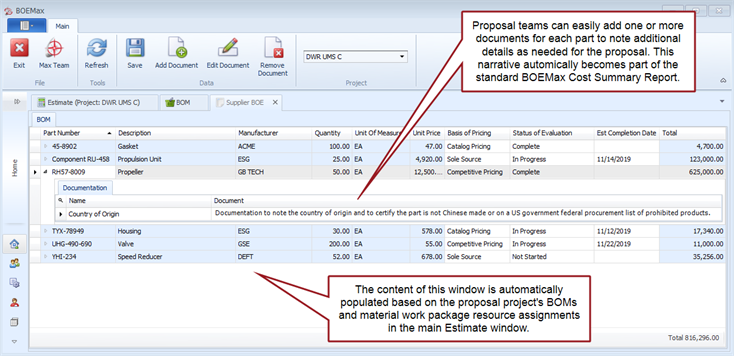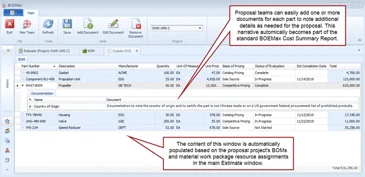BOEMax was designed to help our clients organize their cost estimate data and narrative information in a single database for their proposal submissions. This includes proposal specific hierarchical bills of material (BOMs) that are often built using source data from a master parts or assemblies list maintained in BOEMax. A standard feature in BOEMax proposal software is the ability to also document the supplier basis of estimate (BOE) for these parts or components.
Why is Documenting the Supplier BOE Important?
Accurate estimate software is more important than ever before. Whether you are a contractor to the US federal government or a subcontractor to another government contractor, disclosing information about foreign suppliers is becoming a matter of national security. Based on recent Federal Acquisition Regulation (FAR) interim rules, you may see new solicitation provisions (FAR 52.204-24) and contract clauses (FAR 52.204-25) in an RFP related to telecom equipment or video surveillance services purchased from specific foreign entities. These provisions and contract clauses apply to all acquisitions and flows down to all subcontractors. In your proposal response, you must disclose whether your offer includes the use of prohibited equipment or services. You must also report the use of prohibited equipment or services when you discover they are being used during contract performance.
While concerns about the supply chain in the defense community aren’t new, these recent FAR changes signal the federal government has stepped up their efforts to protect government information and communication systems. The list of prohibited companies, products, or services is likely to continue to expand or evolve as foreign entities change their tactics. Your basis of estimate software should evolve, too
What is the Impact to You?
Be prepared to provide documentation about the suppliers your company contracts with for the parts, components, or services that are included in proposal cost estimates. Proposal teams as well as procurement personnel need to be aware of changing government requirements. Depending on the type of product or service a supplier is providing to your company, company personnel may need to spend additional time to thoroughly vet a supplier and the products they provide to your company. It may be necessary to follow the tiers of suppliers down to the original source for a product. Notes about the supplier and the supplier’s products or services may need to be included as part of the proposal submission. Clear, concise documentation produced by proposal writing software allows the government evaluator to quickly verify there are no issues with the products or services contracted out to other companies.
Steps for Implementing Supplier BOE Documentation in BOEMax
There are a few up-front steps that need to be completed to take advantage of the built-in ability to document the supplier BOE.
Step 1. Define one or more BOMs for the project. The BOMs in BOEMax are hierarchical so you can define individual parts or identify assemblies that are comprised of a hierarchy of parts. All projects in this proposal software share the master parts and assemblies list. When you add parts to a project BOM that do not exist in the master list, the master list is automatically updated. You can build a BOM from the master parts and assemblies list, add items that don’t exist in the master list, or import the data from your material management or manufacturing/enterprise resource planning (M/ERP) system.
The recommended approach is to import validated source data from your internal business systems to create the master parts and assemblies list in BOEMax. The master parts list identifies the part number, description, manufacturer, unit of measure, and unit price. That way proposal teams can use the validated source data to build their project specific BOMs. They identify the part or assembly quantities they need as they build their project specific BOMs.
Proposal teams can also add user defined fields to their BOMs to support internal management or unique proposal requirements. For example, a proposal team could add a project specific flag field to quickly identify parts or assemblies that require additional attention during the proposal development process.
Step 2. Create the material work packages. Be sure to select the material assumption type when you define these work packages.
Step 3. Assign the applicable material resource for the work package. For example, this might be an internal business system code proposal teams use to identity a category or type of material that is defined in the project’s resource structure. The resource structure and rate structure are related; the resource codes determine the applicable material and other overhead rates that apply.
Step 4. Select the applicable parts and assemblies from the project’s BOMs for the work package using the Resource BOM window. This determines the direct cost base value for the assigned material resource. The applicable overhead rates are automatically applied to calculate the total cost.
This is where the right bidding software simplifies life for proposal teams. In BOEMax, the project’s BOMs are automatically updated to populate the assignment column – this identifies the WBS element and control account where the material is used. The software also auto populates the Supplier BOE window for the proposal teams so they can easily add documentation about a part.
What’s Next
The content in the Supplier BOE window is specific to the material items identified in the project’s BOMs and assigned to material work packages. For these material items, the proposal team or procurement personnel can document details such as the basis of pricing or why a specific supplier was selected. They could include bidding information from multiple vendors to substantiate their choice of suppliers. The proposal team can also track whether procurement personnel have completed their evaluation process of the selected supplier’s bid.
The proposal team can add other documentation to support specific solicitation or contract requirements. As desired, you could create a MS Word template that provides a framework of required information about a part. That way proposal teams can use the template to fill in specific details to document a part’s pedigree or provide more information about a specific supplier. This helps to ensure the proposal teams provide the necessary information your customer requires. The following is a screen capture of the Supplier BOE window with example data.

All of this documentation is automatically included in the standard BOEMax Cost Summary Report proposal teams can use to submit cost estimates to government customers. The Cost Summary Report includes separate tabs for:
- The list of manufacturers included in the project’s BOMs with a total value for each supplier.
- Each project BOM with information entered in the Supplier BOE window. Standard columns include the basis of pricing, status of evaluation, quantity, unit of measure, unit price, and total. Additional columns provide links to narrative documents for each line item. These are the documents proposal teams create in the Supplier BOE window.
- The set of Supplier BOE documents. Simply select which document to view.
Because all of the cost estimate data and narrative information resides in the central BOEMax database, this basis of estimate software allows proposal teams to easily comply with government reporting requirements, including documentation about suppliers. Your customer can verify you have vetted your company’s suppliers and the parts or services they are providing.
Need More Information About the New Requirements?
A good overview of the new compliance obligations can be found in an article in the October 2019 issue of the NDIA National Defense Magazine, titled Contractors Face New Reporting Requirements.
The August 13 2019 issue of the Federal Register (Volume 84, Number 156) published the Federal Acquisition Regulatory Council interim rule prohibiting the use of certain telecom and video surveillance services or equipment.
You can find the new FAR requirements in Part 52 Solicitation Provisions and Contract Clauses. See 52.204-24 and 52.204-25.
There is an easier and faster way to create data driven basis of estimates complete with narrative information and supplier BOE documentation all in one database. Call us today to schedule a demo of our proposal software.
